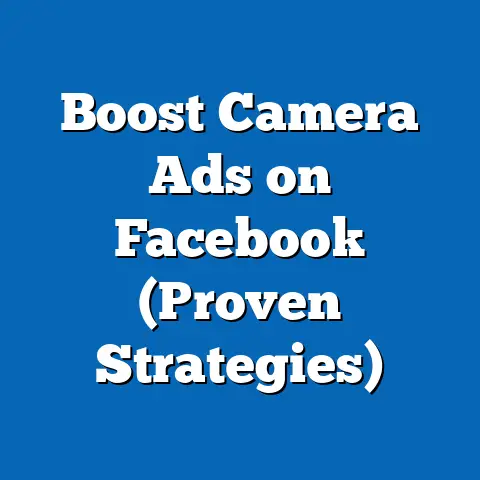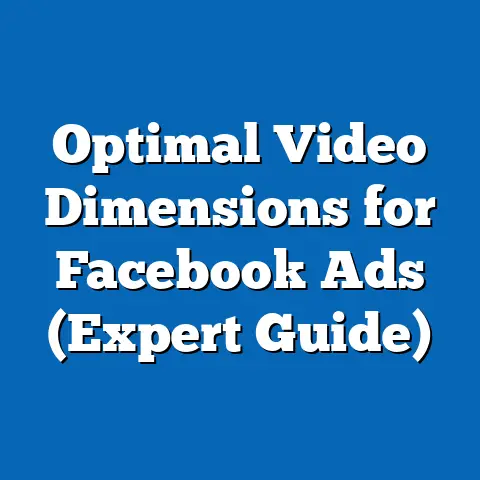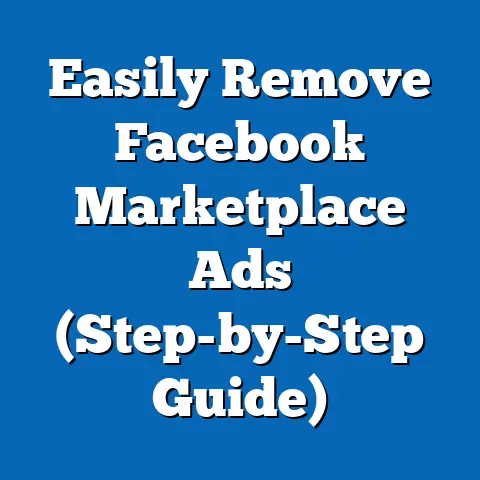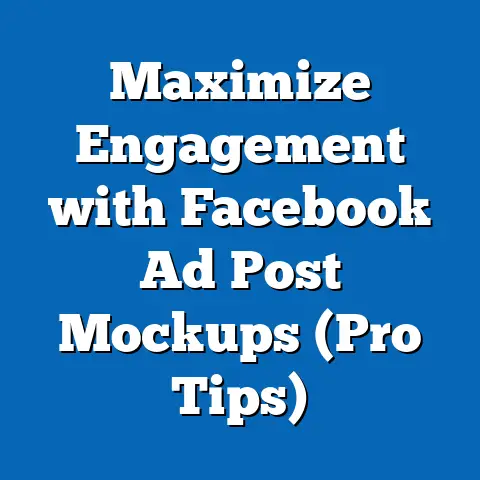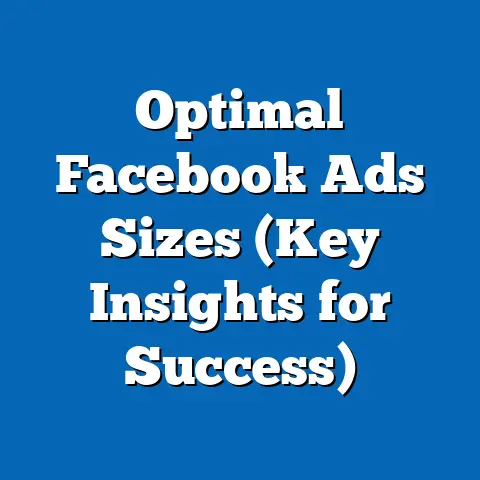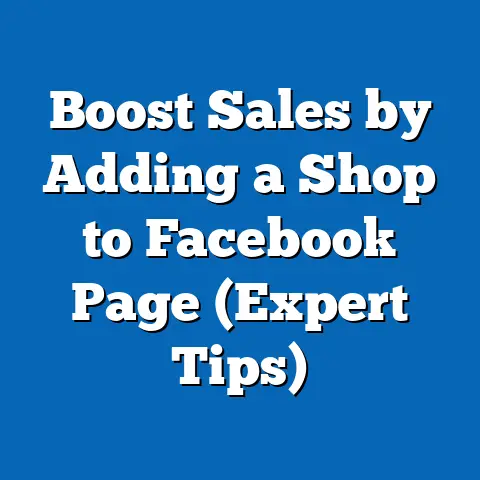Boost Ecommerce Success (Proven Facebook Strategies)
I remember the first time I dipped my toes into the world of eCommerce. It felt like stepping into a vast ocean with no land in sight. I was running a small online store, selling handmade jewelry, and the initial excitement quickly turned into a daunting realization: getting noticed was incredibly difficult. I spent countless nights tweaking my website, crafting product descriptions, and hoping for a miracle. But the sales were trickling in at a snail’s pace, barely covering the cost of materials, let alone my time.
I often found myself tossing and turning, the weight of unpaid bills pressing down on me. The dream of turning my passion into a thriving business felt like it was slipping through my fingers. I knew I needed to find a way to reach more customers, but traditional advertising was too expensive and felt like throwing money into a black hole.
Then, a friend suggested I look into Facebook advertising. At first, I was skeptical. I’d seen so many ads on Facebook myself, and honestly, most of them just felt like noise. But I was desperate, and I decided to give it a shot. Little did I know, this decision would completely transform my business.
It wasn’t an overnight success, of course. There was a learning curve, a lot of trial and error, and a few costly mistakes along the way. But slowly, I started to understand the power of Facebook’s targeting capabilities, the nuances of crafting compelling ad copy, and the importance of tracking my results.
Within a few months, my sales started to climb. I was reaching customers I never would have found otherwise, people who genuinely appreciated my jewelry and were excited to support my small business. The sleepless nights turned into nights filled with the satisfaction of knowing I was building something real, something sustainable.
Today, my jewelry business is thriving, and I owe a huge part of that success to Facebook advertising. It’s not just about the money, though. It’s about the freedom to pursue my passion, the ability to connect with customers on a personal level, and the fulfillment of knowing I’m creating something beautiful and meaningful.
That’s why I’m so passionate about sharing my knowledge and experience with other eCommerce entrepreneurs. I know what it’s like to struggle, to feel overwhelmed, and to dream of something bigger. And I believe that with the right strategies, anyone can achieve their eCommerce goals on Facebook.
So, if you’re ready to take your eCommerce business to the next level, buckle up! This guide is packed with proven Facebook strategies that will help you boost your sales, engage your customers, and build a thriving brand.
Understanding the Facebook Ad Ecosystem
Before diving into the nitty-gritty, let’s take a step back and understand the fundamental workings of the Facebook ad ecosystem. It’s not just about throwing up an ad and hoping for the best; it’s a complex system with various components that need to work in harmony.
How Facebook Ads Work: The Ad Auction
At the heart of Facebook advertising is the ad auction. Every time a user visits Facebook, an auction takes place in real-time to determine which ads they’ll see. This auction considers several factors:
- Your Bid: How much you’re willing to pay for a specific outcome (e.g., a click, an impression, a conversion).
- Ad Quality: Facebook’s assessment of your ad’s relevance and quality based on user feedback and engagement.
- Estimated Action Rate: Facebook’s prediction of how likely a user is to take the desired action (e.g., click on your ad, make a purchase).
The higher your bid, the better your ad quality, and the more likely Facebook thinks users are to engage with your ad, the better your chances of winning the auction. This means that simply throwing money at Facebook ads isn’t enough; you need to create high-quality, relevant ads that resonate with your target audience.
My Experience: I learned this lesson the hard way. In my early days of Facebook advertising, I focused solely on bidding high, thinking that would guarantee me visibility. But my ads were generic and didn’t really speak to anyone. As a result, my ad quality scores were low, and my costs were astronomical. It wasn’t until I started focusing on creating compelling ad copy and targeting the right audience that I saw a real improvement in my results.
Ad Formats: Choosing the Right Canvas
Facebook offers a variety of ad formats, each with its own strengths and weaknesses. Choosing the right format is crucial for capturing attention and conveying your message effectively. Here are some of the most common ad formats:
- Image Ads: Simple and effective for showcasing products or services with a visually appealing image.
- Video Ads: Great for telling stories, demonstrating product features, or capturing attention with engaging visuals.
- Carousel Ads: Allow you to showcase multiple products or features in a single ad, with each card linking to a different landing page.
- Collection Ads: A mobile-first ad format that combines a video or image with a collection of related products, making it easy for users to browse and purchase.
- Instant Experience Ads: Full-screen, mobile-optimized experiences that load quickly and provide an immersive way for users to interact with your brand.
Tip: Experiment with different ad formats to see what resonates best with your target audience. Don’t be afraid to mix and match formats to create a diverse and engaging advertising strategy.
The Facebook Pixel: Your Digital Tracking Device
The Facebook Pixel is a small snippet of code that you place on your website. It acts as your digital tracking device, allowing you to:
- Track Website Visitors: See who’s visiting your website and what actions they’re taking (e.g., viewing products, adding items to their cart, making a purchase).
- Create Custom Audiences: Build audiences of people who have visited your website or taken specific actions, allowing you to retarget them with relevant ads.
- Optimize for Conversions: Tell Facebook to optimize your ads for specific conversions, such as purchases or leads.
The Facebook Pixel is essential for any eCommerce business using Facebook advertising. It provides valuable data that allows you to understand your customers, optimize your campaigns, and drive better results.
My Recommendation: If you haven’t already, install the Facebook Pixel on your website today. It’s a simple process, and the data you’ll gain is invaluable.
Takeaway: Understanding the Facebook ad ecosystem is crucial for success. Focus on creating high-quality ads, choosing the right ad formats, and leveraging the Facebook Pixel to track your results and optimize your campaigns.
Crafting Compelling Ad Content
Now that we’ve covered the basics of the Facebook ad ecosystem, let’s dive into the art of crafting compelling ad content. Your ad copy and creatives are the first things potential customers will see, so it’s essential to make a strong impression.
The Elements of Successful Ad Copy
Great ad copy isn’t just about writing catchy slogans; it’s about understanding your target audience and speaking to their needs and desires. Here are some key elements to consider:
- Headlines: Your headline is the first thing people will see, so it needs to grab their attention and pique their interest. Use strong verbs, numbers, and questions to make your headlines stand out.
- Emotional Triggers: Tap into your audience’s emotions by highlighting the benefits of your product or service and how it can solve their problems or fulfill their desires.
- Strong Calls to Action: Tell people exactly what you want them to do, whether it’s “Shop Now,” “Learn More,” or “Get a Free Quote.”
- Conciseness: Keep your ad copy short and to the point. People have short attention spans, so get your message across quickly and effectively.
Example: Let’s say you’re selling eco-friendly bamboo toothbrushes. Here’s an example of effective ad copy:
- Headline: Ditch Plastic, Go Bamboo! 🌿
- Body: Tired of plastic toothbrushes polluting the planet? Our eco-friendly bamboo toothbrushes are the perfect solution! Made from sustainable bamboo and biodegradable bristles, they’re good for your teeth and good for the environment.
- Call to Action: Shop Now and Save 20%!
My Insight: I’ve found that the most effective ad copy is often the most authentic. Don’t try to be someone you’re not. Speak to your audience in your own voice and let your passion for your product or service shine through.
Creating Eye-Catching Ad Creatives
Your ad creatives (images and videos) are just as important as your ad copy. They need to be visually appealing, relevant to your target audience, and consistent with your brand identity. Here are some tips for creating eye-catching ad creatives:
- Use High-Quality Images: Avoid blurry or pixelated images. Use professional-quality photos that showcase your products or services in the best light.
- Tell a Story: Use your visuals to tell a story that resonates with your target audience. Show people using your product or service and experiencing its benefits.
- Keep it Simple: Don’t overcrowd your visuals with too much text or too many elements. Keep it clean and easy to understand.
- Use Video: Video is a powerful tool for capturing attention and conveying your message effectively. Create short, engaging videos that showcase your products or services in action.
Pro Tip: Use Facebook’s Creative Hub to experiment with different ad creatives and preview how they’ll look on different placements.
Takeaway: Crafting compelling ad content is all about understanding your target audience and speaking to their needs and desires. Use strong headlines, emotional triggers, and clear calls to action. Create eye-catching visuals that tell a story and are consistent with your brand identity.
Targeting the Right Audience
You could have the most compelling ad content in the world, but if you’re showing it to the wrong people, it’s not going to be effective. That’s why targeting the right audience is crucial for Facebook advertising success.
The Importance of Audience Segmentation
Audience segmentation is the process of dividing your target audience into smaller groups based on shared characteristics, such as demographics, interests, behaviors, and more. This allows you to create more targeted ads that resonate with specific groups of people.
Example: Let’s say you’re selling yoga mats. You could segment your audience into different groups based on their interests:
- Yoga Enthusiasts: People who are interested in yoga, meditation, and mindfulness.
- Fitness Fanatics: People who are interested in fitness, exercise, and healthy living.
- Eco-Conscious Consumers: People who are interested in sustainable products and environmentally friendly practices.
By segmenting your audience, you can create ads that speak directly to each group’s interests and needs. For example, you could create an ad for yoga enthusiasts that highlights the mat’s comfort and grip, while creating an ad for eco-conscious consumers that highlights the mat’s sustainable materials.
My Strategy: I always start by creating a detailed customer persona for my ideal customer. This helps me understand their demographics, interests, behaviors, and pain points. Once I have a clear picture of my ideal customer, I can use Facebook’s targeting options to reach them effectively.
Facebook’s Targeting Options: A Treasure Trove of Data
Facebook offers a wide range of targeting options, allowing you to reach specific groups of people based on their:
- Demographics: Age, gender, location, education, relationship status, and more.
- Interests: Hobbies, activities, and topics they’re interested in.
- Behaviors: Purchase behaviors, device usage, travel habits, and more.
- Connections: People who like your page, friends of people who like your page, or people who have interacted with your website or app.
Tip: Don’t be afraid to experiment with different targeting options to see what works best for your business. Start with broad targeting and gradually narrow it down as you gather more data.
Custom Audiences: Reaching Your Existing Customers
Custom Audiences allow you to target people who have already interacted with your business, such as:
- Website Visitors: People who have visited your website or specific pages on your website.
- Customer Lists: People who are on your email list or in your customer database.
- App Users: People who have downloaded or used your mobile app.
- Facebook Page Engagers: People who have liked your page, commented on your posts, or watched your videos.
Custom Audiences are incredibly powerful because you’re targeting people who are already familiar with your brand and have shown an interest in your products or services.
My Success: I’ve had a lot of success using Custom Audiences to retarget website visitors who abandoned their shopping carts. By showing them ads for the products they left behind, I’ve been able to recover a significant number of lost sales.
Lookalike Audiences: Expanding Your Reach
Lookalike Audiences allow you to reach new people who are similar to your existing customers. Facebook analyzes your Custom Audiences and identifies people who share similar demographics, interests, and behaviors.
Lookalike Audiences are a great way to expand your reach and find new customers who are likely to be interested in your products or services.
Takeaway: Targeting the right audience is essential for Facebook advertising success. Use audience segmentation to create more targeted ads that resonate with specific groups of people. Leverage Facebook’s targeting options, Custom Audiences, and Lookalike Audiences to reach the right people with the right message.
Utilizing Facebook’s Advanced Features
Facebook is constantly evolving, adding new features and capabilities to its advertising platform. To stay ahead of the curve, it’s essential to understand and utilize these advanced features.
Retargeting: Bringing Customers Back
Retargeting is the practice of showing ads to people who have previously interacted with your website or app. It’s a powerful way to bring customers back who may have abandoned their shopping carts, viewed specific products, or shown an interest in your brand.
Example: Let’s say someone visits your website and views a specific product but doesn’t add it to their cart. You can use retargeting to show them ads for that product on Facebook, reminding them of their interest and encouraging them to make a purchase.
My Tip: Use dynamic retargeting to show people ads for the exact products they viewed on your website. This is a highly effective way to personalize your ads and increase conversions.
Dynamic Ads: Personalized Product Recommendations
Dynamic Ads allow you to automatically show people ads for products they’re likely to be interested in based on their browsing behavior on your website or app.
Dynamic Ads are particularly useful for eCommerce businesses with large product catalogs. They save you time and effort by automatically creating personalized ads for each user.
Pro Tip: Use dynamic ads to cross-sell and up-sell to existing customers. Show them ads for products that complement their previous purchases or offer a higher-end version of a product they’ve already bought.
Collection Ads: Showcasing Your Products
Collection Ads are a mobile-first ad format that combines a video or image with a collection of related products. They’re a great way to showcase your products in a visually appealing and engaging way.
When someone clicks on a Collection Ad, they’re taken to an Instant Experience, which is a full-screen, mobile-optimized landing page that allows them to browse your products and make a purchase.
Takeaway: Facebook offers a range of advanced features that can help you boost your eCommerce success. Utilize retargeting to bring customers back, dynamic ads to personalize product recommendations, and collection ads to showcase your products in a visually appealing way.
Analyzing and Optimizing Campaign Performance
Running Facebook ads is just the first step. To truly succeed, you need to analyze your campaign performance and make data-driven decisions to optimize your strategies.
Key Metrics to Track
There are several key metrics you should track to measure the success of your Facebook ad campaigns:
- Impressions: The number of times your ad was shown.
- Reach: The number of unique people who saw your ad.
- Click-Through Rate (CTR): The percentage of people who clicked on your ad after seeing it.
- Conversion Rate: The percentage of people who completed a desired action (e.g., made a purchase) after clicking on your ad.
- Cost Per Click (CPC): The average cost you paid for each click on your ad.
- Cost Per Acquisition (CPA): The average cost you paid for each conversion.
- Return on Ad Spend (ROAS): The amount of revenue you generated for every dollar you spent on advertising.
My Recommendation: Focus on ROAS as your primary metric. It gives you a clear picture of the overall profitability of your campaigns.
Interpreting the Data
Once you’re tracking these metrics, it’s important to understand how to interpret the data. Here are some things to look for:
- High Impressions, Low Reach: This suggests that you’re showing your ad to the same people multiple times. Consider expanding your targeting or refreshing your creatives.
- High CTR, Low Conversion Rate: This suggests that your ad is attracting attention, but your landing page is not converting. Optimize your landing page to improve the user experience and make it easier for people to make a purchase.
- High CPC, Low ROAS: This suggests that you’re paying too much for clicks and not generating enough revenue. Consider lowering your bids, improving your ad quality, or refining your targeting.
Pro Tip: Use A/B testing to experiment with different ad copy, creatives, and targeting options. This will help you identify what works best for your audience and optimize your campaigns for maximum performance.
Takeaway: Analyzing and optimizing your campaign performance is crucial for Facebook advertising success. Track key metrics, interpret the data, and make data-driven decisions to refine your strategies and improve your results.
Case Studies of Successful Facebook Ad Campaigns
To illustrate the power of Facebook advertising, let’s take a look at some real-life examples of eCommerce brands that have successfully used Facebook ads to grow their businesses.
Case Study 1: Warby Parker
Warby Parker is an online eyewear retailer that has built a successful brand through effective Facebook advertising. They use a combination of image ads and video ads to showcase their products and tell their brand story.
One of the key strategies Warby Parker uses is retargeting. They show ads to people who have visited their website and viewed specific products, reminding them of their interest and encouraging them to make a purchase.
Case Study 2: MVMT Watches
MVMT Watches is another eCommerce brand that has achieved significant growth through Facebook advertising. They use a variety of ad formats, including image ads, video ads, and carousel ads, to showcase their watches and accessories.
MVMT Watches also leverages Facebook’s targeting options to reach specific groups of people based on their interests and behaviors. They target people who are interested in fashion, style, and watches, and they also target people who have purchased similar products in the past.
Key Takeaways from These Case Studies:
- Use a Variety of Ad Formats: Don’t rely on just one ad format. Experiment with different formats to see what works best for your audience.
- Leverage Retargeting: Retargeting is a powerful way to bring customers back who have shown an interest in your brand.
- Target the Right Audience: Use Facebook’s targeting options to reach specific groups of people who are likely to be interested in your products or services.
- Tell Your Brand Story: Use your ads to tell your brand story and connect with your audience on an emotional level.
Future Trends in Facebook Advertising for eCommerce
The world of Facebook advertising is constantly evolving, so it’s important to stay up-to-date on the latest trends and features. Here are some upcoming trends that eCommerce businesses should be aware of:
- AI-Driven Ads: Facebook is increasingly using artificial intelligence to automate and optimize ad campaigns. Expect to see more AI-powered features that help you create better ads, target the right audience, and optimize your bids.
- Augmented Reality (AR) Ads: AR ads allow users to virtually try on products or experience your brand in a more immersive way. This is particularly useful for eCommerce businesses selling products like clothing, makeup, or furniture.
- Privacy Changes: Apple’s iOS 14 update has had a significant impact on Facebook advertising, making it harder to track users and measure conversions. Expect to see more privacy changes in the future, so it’s important to adapt your strategies to be less reliant on third-party data.
My Prediction: In the future, Facebook advertising will be more personalized, automated, and privacy-focused. eCommerce businesses that can adapt to these changes will be the ones that thrive.
Conclusion
Facebook advertising can be a powerful tool for boosting your eCommerce success. By understanding the Facebook ad ecosystem, crafting compelling ad content, targeting the right audience, utilizing Facebook’s advanced features, and analyzing your campaign performance, you can drive more traffic, generate more leads, and increase your sales.
It’s not always easy, and there will be challenges along the way. But with the right strategies and a willingness to learn and adapt, you can achieve your eCommerce goals on Facebook.
So, take the first step today. Install the Facebook Pixel on your website, create a compelling ad, and start targeting your ideal customer. You might be surprised at what you can achieve.
I remember feeling completely lost and overwhelmed when I first started my eCommerce journey. But with perseverance, hard work, and the power of Facebook advertising, I was able to turn my passion into a thriving business. And I believe you can do the same. Go out there and make it happen!

